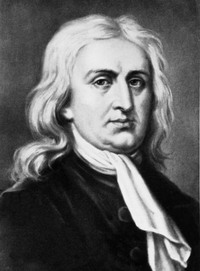Login form
Sir Isaac Newton
 Isaac Newton was always wondering about the things he saw around him. What holds the Moon and planets in the sky? How does a rainbow form? He uncovered basic laws of nature. He used mathematics to explain these laws and predict how objects would behave. He became one of the greatest scientists of all time.
Isaac Newton was always wondering about the things he saw around him. What holds the Moon and planets in the sky? How does a rainbow form? He uncovered basic laws of nature. He used mathematics to explain these laws and predict how objects would behave. He became one of the greatest scientists of all time.
STUDENT YEARS
Newton was born in Woolsthorpe, England, on December 25, 1642. He loved to build mechanical models, but he was not a good student. His mother took him out of school so that he could help run the family farm. Newton did not like farming.
He liked to read and study on his own. A former teacher knew that Newton was very smart and helped him go to the University of Cambridge.
After Newton graduated, bubonic plague broke out in Cambridge. Many people got sick and died. Newton went back to the family farm for two years until the plague died down. He came up with many of his greatest ideas from 1665 to 1667 while he was alone in the countryside.
HIS GREATEST WORK
Newton invented a new kind of mathematics called calculus. Today, scientists and engineers use calculus to solve many kinds of problems.
Newton came up with theories about gravity and motion. He thought that the same force pulling people and apples down to Earth keeps the Moon going around Earth and the planets going around the Sun. He used mathematics to prove his theories.
Newton used a prism, a piece of glass with many sides, to study light. He found that sunlight is made up of every color in the rainbow.
LIFE AT CAMBRIDGE
Newton went back to Cambridge and became a professor of mathematics. He built the first reflecting telescope, which uses mirrors instead of lenses. He became famous for his calculus, but he did not tell many people about his theory of gravity. He was shy and modest and did not want other scientists to criticize his work.
Finally his friends had him write a book about gravity and motion titled Principia Mathematica. Scientists called the book a masterpiece. Newton was made a knight. When he died on March 20, 1727, he became the first scientist to be buried in Westminster Abbey in London.
Source: Microsoft ® Encarta

